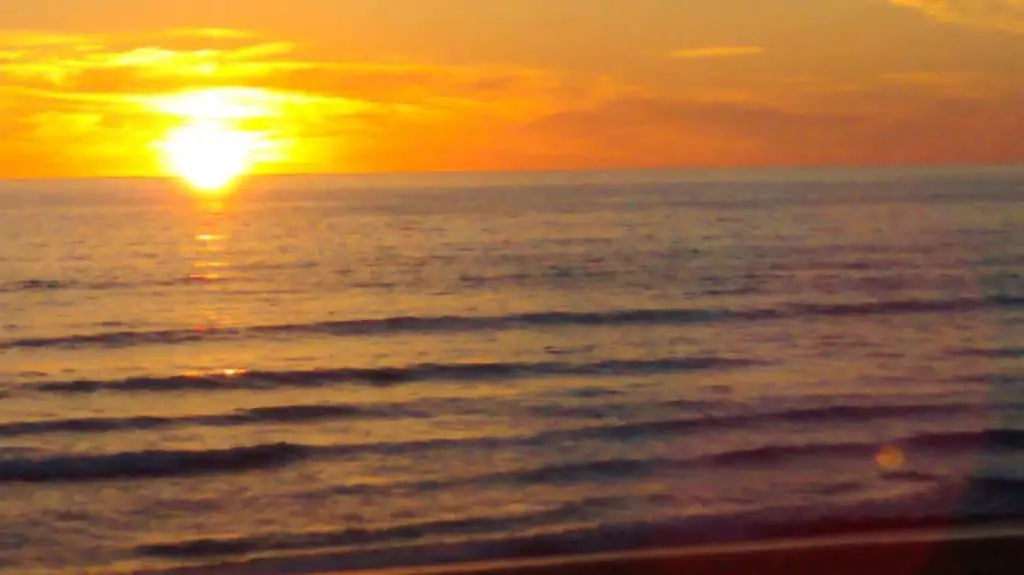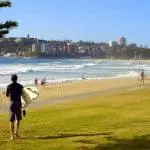What is the Best Time to Surf for Beginners? EVERY Factor Considered
There is a lot to learn when it comes to learning to surf with so many factors to consider.
Getting the right board and wetsuit usually come first, followed by finding the best spots for you to surf at.
However, once you do find somewhere to surf, then comes the next question in learning to surf.
So, what is the best time to surf for beginners? In the morning is usually the best time because the wind is often lightest and there will be less of a crowd. However, it depends on your local spots, tides, weather and conditions, as will be explained in this post.
Since there are quite a few more things to consider, let’s break it down and make things very clear and easy for you to figure when you can surf your chosen spot at the perfect time for learning to surf.
What are good surf conditions for beginners?
Learning to surf, good conditions are actually quite easy to find since smaller waves are best.
Beginner surfers should be using larger boards, which means they can then ride smaller waves and have a lot of fun on them.
This is also helpful because smaller waves are safer since they are less powerful and break closer to shore, making it a more fun experience for the beginner surfer.
To go along with small waves, you really want light winds when learning to surf, or surfing in general. all the winds create waves, when they are strong at the beach they can often ruin the waves you want to surf.
As such, finding a time when the wind is lightest, which is often in the morning but depends on your local conditions, means that you can find the best waves or conditions for learning to surf.
Another aspect of good surf conditions for beginners is having some other people around. Now, it should be said that you don’t want really crowded spots, but also it’s good to have other people around when learning because of the ‘safety in numbers’ it provides.
If something does go wrong, having just a few other people around is an extremely helpful and positive thing so remember this before you paddle out, especially as a learner.

Why do surfers surf in the morning?
Surfing in the morning is extremely popular as the wind is usually lightest and there are fewer people out in the surf.
For most places, the wind will pick up as the temperature increases throughout the day.
This often leads to a wind coming from the sea towards shore, called an ‘onshore’ wind; this is not great since it causes the waves break less evenly and is not good for surfing.
However, going surfing in the morning, you will have the best chance of light or ‘offshore’ winds, where the wind blows from the land out to sea.
An offshore wind is ideal for surfing as it makes the waves hold up better and is more fun for riding them.
There are a couple of exceptions to this rule, with Bali’s Bukit Peninsula being one. There, the winds are often not very good first thing in the morning during the dry season, with people waiting for the ‘morning sickness’ to pass and the offshore winds to kick in later in the day.
Surfing at High or Low Tide: Which is Better?
When choosing between high or low tide for a surf, it really depends on your chosen spot and when that is safest to surf.
Most beach breaks, with waves that break on a sandy beach, are usually fine for much of the tide.
You may also find that, if you surf at an extreme low tide, the waves can dump and not break well for surfing. This appears to be pretty common around the globe, although it doesn’t happen everywhere so again pay attention to your local spot and conditions.
There may also be exposed or shallow rocks, even on an otherwise sandy beach.
And as a general rule on top of that, you will usually want to avoid the extreme high or low tides as these both have issues. A shorebreak may be common at high tide, as we’ll look at below.
Shorebreaks at High Tide
Another thing to bear in mind is that you don’t want to surf at a spot with what’s called a shorebreak’ when you are a beginner.
A shorebreak is so named because of the way waves can jump directly onto the sand at high tide.
This doesn’t happen everywhere, but where it does, it can make entry and exit from the water difficult or even dangerous. A shorebreak can also lead to injuries or broken boards if you are not careful.
That said, most shorebreaks only appear at high tide, so if you know this then you can simply check the tide times and avoid the shore break time.
Incoming and outgoing Tides
As well as considering the stage of the tide, you should also think about what the tide is doing and whether it is incoming or outgoing.
An incoming tide is anytime after low and before high, while an outgoing tide is anytime after high and before low.
You may also hear surfers refer to these tides as the pushing tide for the incoming, and they dropping tide for the outgoing.
As a general rule, the incoming tide is probably safer for surfing at most surf spots. I say this because on an outgoing tide, you can often experience rips or currents that will pull you out to see with that dropping tide. Although still possible, rips going out to sea are less common on an incoming tide, so they are likely safer for most learners in this respect.
Remember that this is not guaranteed and that once again you should check your local area or surf spots to figure out exactly what happens with the stage of the tide.
Tips for Best Tide Times
In general, the best advice is to consult a surf guide for your local conditions. This could be in a book or online but note that usually surfing 1-2 hours before or after either high or low is best to avoid the problems mentioned above.
Crowds
Surfing with crowds when you are learning is a bit of a balancing act. As mentioned above, you do want some people around to give you the peace of mind that if anything goes wrong they can help you. However, especially when you are learning, you may find it hard to catch waves if the waves are crowded and it also can be quite intimidating.
With this in mind, going early in the morning is usually the best way to avoid the crowds as people simply don’t get up that early. Although the hardcore surfers do get in early, you’ll still see far fewer people in the surf if you can get to the beach early.
On top of this, again as mentioned previously, the winds will usually be lighter first thing in the morning as well, making it that bit easier for surfing.
Daylight
You will always want to go surfing in daylight, and although that sounds strange, some people actually do go surfing at night! new line obviously, surfing can be a dangerous sport if if not done correctly, so going out in the dark adds to the danger. however, if you simply go out anytime with a good amount of daylight, you should have a safe and fun learn to surf experience without the worries of anything going wrong.
Surfing at Dusk
If you are planning to serve in the evening comma at dusk, then always allow yourself plenty of time to paddle back in and make sure that you get out in good time before sunset. this is because, if you get caught in a rip current or something similar, with fading light you can put yourself in some serious danger, even if the conditions are perfect at that hour!
try to be aware always of how long the Paddle might take you, who else is around you in the surf and never be the last one out comic especially when you are a beginner. from my own surfing experience, I’ve noticed that you usually have about 45 minutes after sunset of any kind of daylight, so really it’s best to get out just as the sunset if you are surfing at dusk for reasons of safety.

Sharks
Something you absolutely need to know when choosing the right time to surf is whether there are sharks in your local area.
I am not referring to harmless sharks that are around, rather sharks that might attack you as a surfer. Although shark attacks are statistically extremely rare, paddling out at certain times of day can increase your risk of being attacked by a shark as a surfer, just as anyone in the sea.
Since sharks have incredible eyesight, they prefer to hunt for food around the hours of dawn and dusk because they can see a silhouette of their prey, without the prey to seeing them.
This predatory advantage means that sharks are looking for food in the early morning and late afternoon/evening hours.
So, judging the eriska of shark attack in your area, you may wish to avoid surfing at extreme times of dawn or dusk to minimise your chances of encountering a shark, even though it’s still extremely rare.
Related Questions
Do waves get bigger at night? No, they do not get bigger at night, although they may sound louder to the human ear given the lesser amount of human activity and noise pollution at the beach.
That said, local weather conditions can mean that waves get bigger overnight but this is only as part of a general trend for an increase in wave size over time and is not related to day or night.
What size waves should a beginner surf? Waves that are knee to waist high are absolutely perfect for beginners since they offer enough power to ride without being so powerful that they can cause you problems. They will also usually break close to shore, which again makes them really well suited for learners.
The closer a wave breaks to shore, the easier it is to get back to dry land if something goes wrong when you are learning to surf.
How late can you surf? Usually you will have about 45 minutes of daylight left after a sunset, so check the sunset time and add 45 minutes to it as a safe option. That said, there are people out there who do surf at night, but this is usually with a full moon or some kind of street lighting nearby.
However, there is a greatly increased risk of things going wrong when surfing at night so think carefully about doing it before you do.









